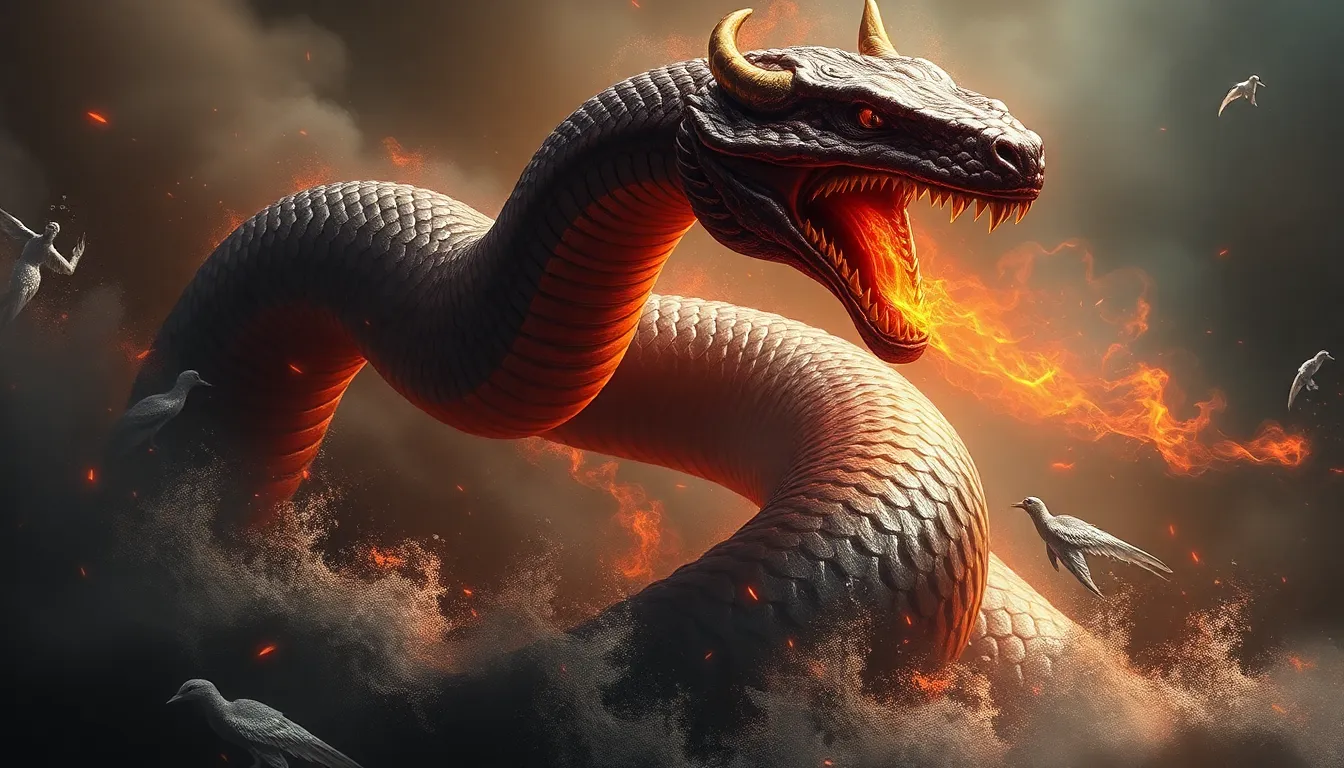The Serpent’s Scale: Myths of Transformation and Power
I. Introduction
Throughout history, serpents have held profound symbolic significance in various cultures around the globe. These enigmatic creatures often embody dual aspects of existence, representing both good and evil, creation and destruction, transformation and stagnation. The concept of transformation, particularly in relation to power, is intricately woven into the mythos surrounding serpents. This article aims to explore the multifaceted symbolism of serpents, focusing on their role in mythology, religion, and modern interpretations, while also delving into the transformative power they represent.
II. The Serpent as a Symbol in Mythology
Serpents possess a dual nature in many mythologies, often embodying the dichotomy of good versus evil. This complexity makes them compelling figures in various narratives across cultures.
A. The Dual Nature of Serpents: Good vs. Evil
In numerous traditions, serpents can be seen as both protectors and destroyers, emphasizing the balance of nature and the human experience. They are often linked to wisdom, healing, and rebirth, while simultaneously being associated with temptation, chaos, and danger.
B. Key Myths Featuring Serpents Across Different Cultures
- Ancient Mesopotamia: Tiamat and the Creation Myth
- Greek Mythology: The Gorgon and Medusa
- Hindu Mythology: The Naga and Its Significance
Tiamat, a primordial goddess depicted as a monstrous serpent, plays a central role in the Babylonian creation myth. Her battle with the god Marduk signifies the clash between chaos and order, illustrating the transformative power of creation through conflict.
In Greek lore, Medusa, one of the Gorgons, is depicted with serpents for hair. Her gaze transforms people into stone, symbolizing the fear and power associated with the serpent archetype, as well as the theme of transformation through fear and isolation.
The Naga, a serpent deity in Hinduism, symbolizes fertility, water, and the underworld. These serpents are revered as protectors and bringers of rain, embodying the duality of life-giving forces and the potential for destruction.
III. The Serpent’s Scale: An Element of Transformation
The biological characteristic of serpents shedding their skin serves as a powerful metaphor for transformation and renewal.
A. The Biological Transformation of Serpents (Molting)
Molting is a natural process that signifies growth and the shedding of the old. This physical transformation embodies the idea of letting go of the past to embrace a new phase of existence.
B. Symbolic Representation of Growth and Renewal
The act of shedding skin is a potent symbol of personal growth, reflecting the need for individuals to shed their old selves to progress and evolve. This cycle of death and rebirth is central to many mythological narratives.
C. Connection to Personal Transformation in Mythological Narratives
In many myths, protagonists undergo transformative experiences that mirror the serpent’s molting process, often emerging stronger and wiser from their trials.
IV. Serpents and Power: Historical Perspectives
Throughout history, serpents have been emblematic of authority and power in various civilizations.
A. The Serpent as a Symbol of Authority in Ancient Civilizations
- Pharaohs of Egypt and the Uraeus
- Serpents in Mesoamerican Cultures: Quetzalcoatl
The Uraeus, a representation of a rearing cobra, was worn by ancient Egyptian pharaohs as a symbol of sovereignty and divine authority, signifying protection and power.
Quetzalcoatl, the feathered serpent deity of Mesoamerican cultures, embodies the duality of the earth and sky, representing life, knowledge, and the transformative power of creation.
B. The Use of Serpentine Imagery in Heraldry and Symbolism
Serpents frequently appear in heraldry and symbolism, representing qualities such as vigilance, cunning, and guardianship across various cultures, further cementing their association with power and authority.
V. The Serpent in Religion and Spirituality
Serpents have played significant roles in religious texts and spiritual practices, often embodying complex themes of creation, temptation, and renewal.
A. Serpents in Religious Texts: The Bible and the Serpent in Eden
The serpent in the Garden of Eden represents temptation and the fall of man, highlighting the duality of knowledge and sin, thus cementing its role as a powerful symbol in Judeo-Christian traditions.
B. The Role of Serpents in Spiritual Practices and Rituals
In various spiritual traditions, serpents are revered as symbols of healing and transformation, often utilized in rituals aimed at personal and communal renewal.
C. Modern Interpretations of Serpent Symbolism in Spirituality
Contemporary spirituality often reinterprets serpents as symbols of wisdom and empowerment, encouraging individuals to embrace their transformative potential.
VI. Transformation Myths: Serpent Tales Across Cultures
Folklore and fairy tales often feature serpents as transformative figures, highlighting their role in human development and psychological growth.
A. Folklore and Fairy Tales Featuring Transformative Serpents
Many cultures possess tales where serpents lead characters through transformative journeys, often acting as guides or guardians of wisdom.
B. Psychological Interpretations of Serpent Transformations
Psychologically, serpent transformations can symbolize the individual’s journey through personal fears and challenges, leading to self-discovery and empowerment.
C. Case Studies of Specific Myths and Their Meanings
Examining specific myths can unveil deeper meanings behind the serpent’s transformative nature, revealing the complex relationship between fear, growth, and power.
VII. The Serpent as a Representation of Duality
The serpent embodies the balance of creation and destruction, representing a fundamental duality that permeates existence.
A. The Balance of Creation and Destruction
Serpents symbolize the cyclical nature of life, where creation often arises from destruction, reflecting the natural order of the universe.
B. The Serpent in Alchemy: The Ouroboros
The ouroboros, a serpent eating its own tail, symbolizes the eternal cycle of life, death, and rebirth, illustrating the interconnectedness of all existence.
C. The Coexistence of Fear and Reverence in Serpent Symbolism
This duality evokes a complex relationship with serpents in human culture, where they are both feared and revered as potent symbols of wisdom and power.
VIII. Modern Interpretations of Serpent Myths
In contemporary society, serpent symbolism has experienced a resurgence in art, literature, and media, reflecting evolving understandings of their meanings.
A. The Resurgence of Serpent Symbolism in Contemporary Art and Literature
Artists and writers increasingly draw on serpent imagery to explore themes of transformation, identity, and personal empowerment.
B. The Serpent in Popular Culture: Films and Media Representations
Serpents appear in various films and media, often representing complex characters that embody the struggle between good and evil, transformation, and power dynamics.
C. The Relevance of Serpent Myths in Modern Societal Contexts
As societies confront issues of change and identity, serpent myths continue to resonate, providing insight into the human condition and the ongoing quest for personal and collective transformation.
IX. The Impact of Serpent Myths on Identity and Culture
The rich tapestry of serpent myths has significantly influenced cultural identities and narratives around the world. They serve as a reminder of the complexities of existence, emphasizing the transformative power of fear, knowledge, and resilience.
In conclusion, the serpent remains a potent symbol of transformation and power across cultures and time. Its dual nature reflects the complexities of life, encouraging individuals to embrace their transformative journeys and the power inherent within them. As we continue to explore the myths and meanings surrounding serpents, we uncover deeper insights into our own identities and the world around us.




